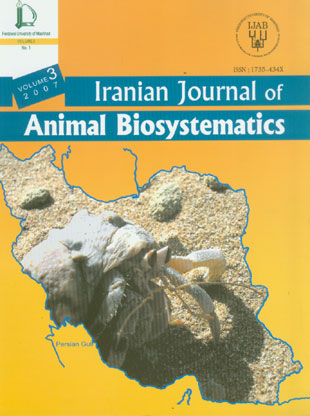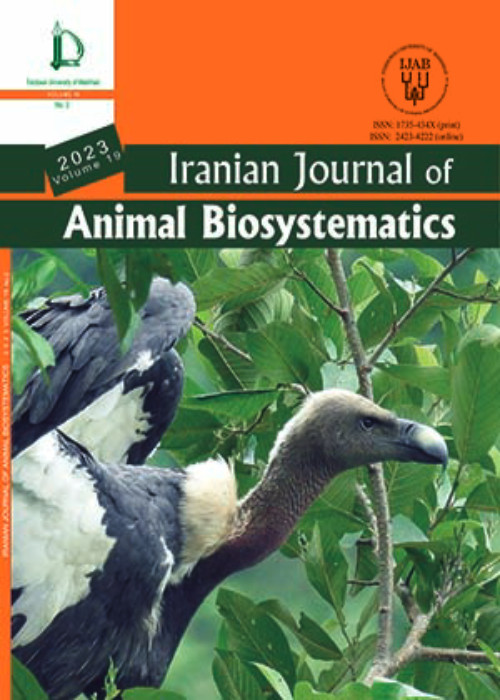فهرست مطالب

Iranian journal of animal biosystematics
Volume:3 Issue: 1, Winter-Spring 2007
- تاریخ انتشار: 1386/10/11
- تعداد عناوین: 8
-
-
Page 1The present study provides the first large scale survey on intertidal ichthyofauna along the coastline of Iran from Gawater Bay (Border of Pakistan) in the Gulf of Oman to ArvandKenar (Border of Iraq) in the Persian Gulf. This study was carried out in the years 2005-2006 at 15 stations, including mangrove, mudflat and rocky shores. Specimens were collected at low tide from tide pools, using chlorine and hand net. Although 36 species from 15 families were collected only 17 species including Alticus kirkii, Antennablennius bifilum, A. variopunctatus, Istiblennius edentulous, I. pox, I. spilotus, Parablennius opercularis, Omobranchus fasciolatus, O. mekranensis, O. punctatus, (belong to family Blenniidae) and Boleophthalmus dussumieri, Periophthalmus waltoni, Scartelaos tenuis, Acentrogobius dayi, Bathygobius meggitti, Cryptocentroides arabicus and Istigobius ornatus (belong to family Gobiidae) were regarded as permanent residents.
-
Page 15A spring-stream called “Ghadamgah” in Fars province, southern Iran, which holds more than 60 aquatic vertebrate and plant species belonging to 46 genera and 33 families is almost the biologically richest water body of Fars province. The diversity is especially in its endemic fishes which are under threats nowadays. One of the factors, if not the one, which has kept this system more or less in its natural status is the religious beliefs in this place and the rituals of indigenous believers acting as a sanction against environmental destruction for many years till recently. But now this does not retain a high priority and has become displaced by economic and political factors. Water diversion, drainage rehabilitation, water pollution, and drought, development of intensive aquaculture and introduction of non – native fish species are the main factors affecting the biological diversity of this system. Thus, conservation of this very small fragile hotspot habitat is very important.
-
Page 25The hermit crabs fauna of the Gulf of Oman are not well known. Material of the present study was collected from 14 intertidal localities along the Iranian coast of the Gulf of Oman. The eight hermit crab species belong to three families Coenobitidae (Coenobita scaevola), Diogenidae (Diogenesavarus, D. planimanus, D. custos, Clibanarius signatus, C. virescens and C. longitarsus) and Paguridae (Pagurus kulkamil). Amongst hermit crabs of the present study, Diogenes customs and Pagurus kulkamii are new records for the area. Notes on habitat preferences, most common host shells and geographical distributions for all species are provided.
-
Page 37During hibernation period from Mid October to Late March, we removed testis of Laudakia caucasia. Based on histological and statistical analyses we obtained two phases in spermatogenesis in this lizard as follows: (a) from October to December, in which the spermatogenesis is inactive and (b) from January to March, in which the spermatogenesis is active. Spermatogenesis during late hibernation occurred without spermiogenesis. An evidence for this is that the first and secondary spermatocytes produced but lumen of the seminiferous tubules were without spermatozoa.
-
Page 43Gerbillus nanus is a highly polytypic species exhibiting considerable geographical variation, both in external and cranial characters. In the present study, specimens were collected from different localities in the northeastern, eastern, central and southern Iran. The values for external end cranial measurements have been given. The specimens present the existence of two different morphotypes of Baluchistan gerbil – short-tailed and long-tailed – existing sympatrically, especially in the southern parts of Iran. Moreover, in this study, one specimen was captured from Abarkouh desert and identified as Gerbillus cfr. henleyi which is the first report of the presence of this species in Iran. This new record expands the distribution of G. henleyi because it is the most eastern record of this species..
-
Page 49There is little known about the systematics and population structure of Indian gerbils (Tatera indica) in Iran. In the present study six populations of T.indica from different localities of Iran were compared according to morphology, morphometry and karyological studies to determine the status of these populations at the sub specific level. The univariate, bivariate and multivariate statistical analyses of four external and 18 cranial morphometric characters in Tatera indica (Rodentia: Muridae) were performed using 84 specimens collected from widely scattered geographical localities.The results of MANCOVA showed that there are no significant differences between sexes. In order to show variation between samples and the significance of cranial variables CDA and PCA analyses were carried out using log-transformed data. The results of CDA analysis indicated discrimination between samples. The results of the univariate and multivariate analysis showed that the morphometric characteristics of the Indian gerbil populations in Iran are slightly different. Also, the results of the GM analysis showed two major phonetic groups which indicates separation of the northern and the southern populations. Karyological results showed that 2N=68 and NFa=80 in all karyotyped specimens which are similar to findings of previous authors. There are not any variations in 2N and NFa of the studied specimens. On the basis of the CDA, PCA and GM analyses there are two main phenetic groups in these populations which might be related to the sub-specific condition of them. However, due to methodological problems, other techniques such as molecular studies must be applied for determination of true status of these groups.
-
Page 63Members of the tribe Scaurini Billberg، 1820، have been systematically studied by Solier (1838)، Reitter (1914)، Koch (1935، 1958)، Peyerimhoff (1948)، Español (1954، 1960)، Antoine (1953، 1954)، Kocher (1958، 1964)، Reymond (1956 a، 1956 b) and Labrique (1992، 1995 a، 1995 b، 1995 c، 2001، 2004، 2006). The tribe is recorded from the Mediterranean region، South Africa (Koch 1958)، USA: California، Arizona and Texas as well as Mexico (Kaszab، 1982). They are recognized by lack of wings، the keeled eye، conical maxillary palp and hairless antennae with a lengthened last segment and a ridged thorax base (Reitter، 1914). Many species are lapidicolous and myrmecophilous، simulating rigor mortis when disturbed. Some species are troglobite (Antoine 1953).
-
Page 69There are four species of marbled shrimps namely: Saron marmoratus (Olivier, 1811), Saron neglectus De Man, 1902, Saron inermis Hayashi, 1983 and Saron rectirostris Hayashi, 1984. The marbled shrimp, Saron marmoratusis a widespread species in the Indian and Pacific Oceans (see Holthuis, 1947 and Chace, 1997 for details and also Barnard, 1950; Miyake and Hayashi, 1966; McNeil, 1968; Tirmizi and Kazmi, 1972; Kazmi and Kazmi, 1979; Jones, 1986; Kazmi and Kazmi, 1987; Hogarth, 1989; Holthuis, 1993). This species was throughway treated in the study of material collected during the «Siboga Expedition» by Holthuis (1947)


